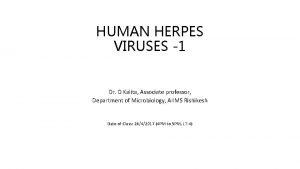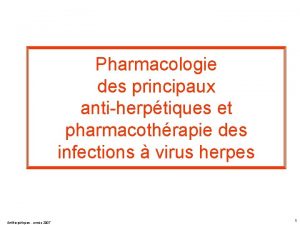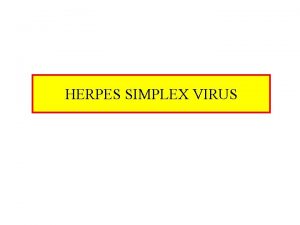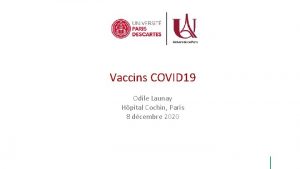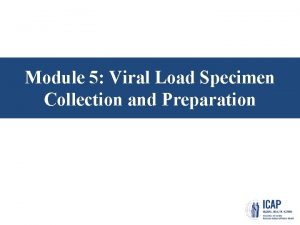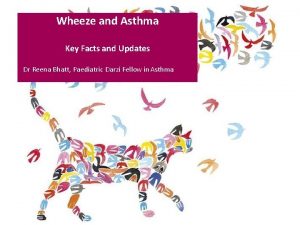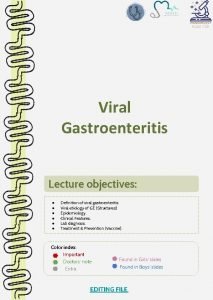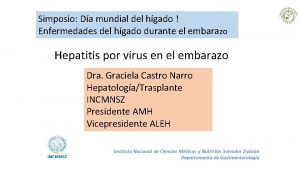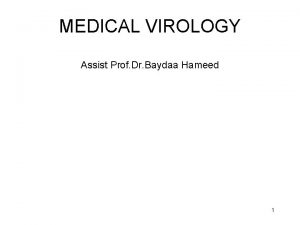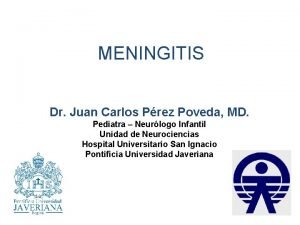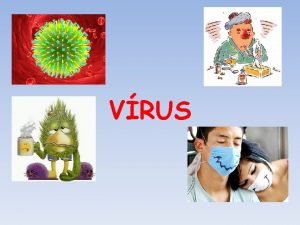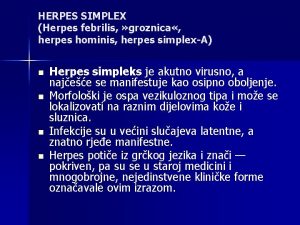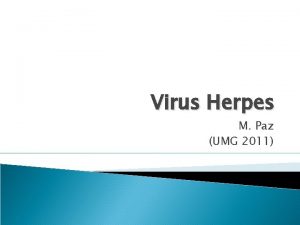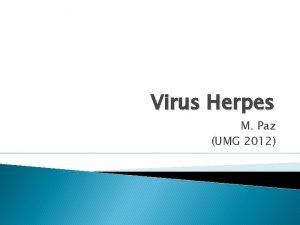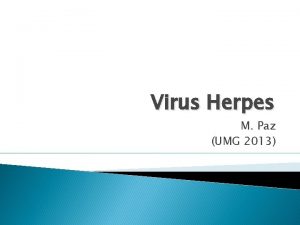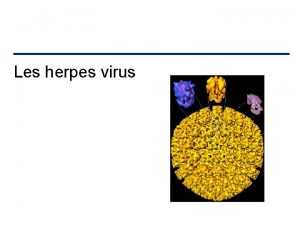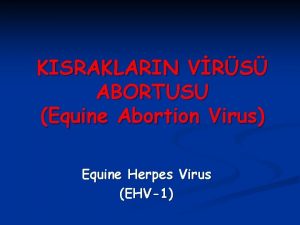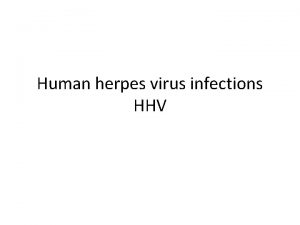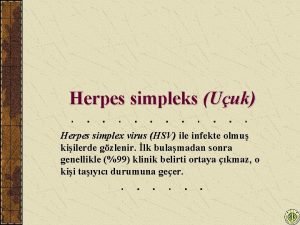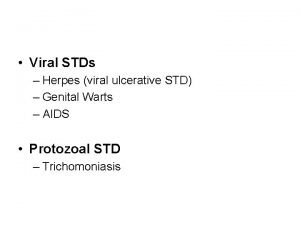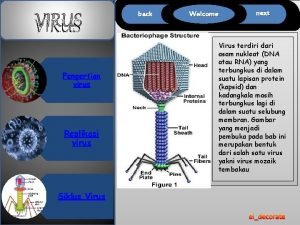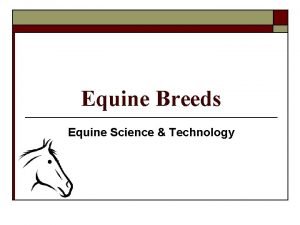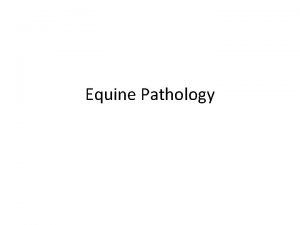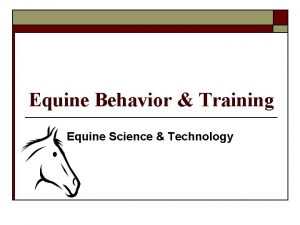EQUINE VIRAL RHINOPNEUMONITIS 1 Synonyms EQUINE HERPES VIRUS




















- Slides: 20

EQUINE VIRAL RHINOPNEUMONITIS 1

Synonyms EQUINE HERPES VIRUS EQUINE VIRAL ABORTION 2

Definition EHV is an acute contagious disease of equines caused by Herpes virus and characterized clinically by respiratory involvement, abortion & encephalopathy. 3

Etiology v. Herpesviridae v. DNA virus. EHV 1: Abortion, rhinopnumonitis and encephalomyelitis. EHV 2: Mild respiratory disorders. EHV 3: Coital exanthema. EHV 4: Rhinopnumonitis. 4

EPIDEMIOLOGY Distribution: World wide distributed. 5

Sources of infection: q. The main source of infection is the infected horse shedding the virus as: q Respiratory secretions. q. Aborted fetus and placenta & uterine discharges. 6

MODE OF TRANSMISSION Inhalation Ingestion 7

SUSCEPTIBLE ANIMALS Horses and donkeys are the main susceptible 8

Factors influencing susceptibility Young ages Pregnant mares Season 9

E. VALUE Storm of abortion Interrupt training and racing schedules 10

PATHOGENESIS After inhalation, it reaches the pulmonary macrophage which transport it to bronchial lymph nodes…. . viremia causing damage to vascular endothelium especially in certain organs (viral tropism): Lung Uterus CNS 11

Clinical signs IP 2 -10 days High morbidity Low mortality Mild fever. Short dry cough. Dyspnoea, rhinitis & conjunctivitis. serous nasal discharge become muco-purulent. Then cough became productive. Abortion 2 -16 weeks after viral exposure and abortion occurs between 8 -11 months (late stage abortion). 12

Encephalopathy Rapid onset of ataxia Paresis Inability to pass urine or manure Recumbence leading to death 13

An adult horse affected with equine herpes myeloencephalitis due to equine herpes virus (EHV) - 1. The hind limbs are more affected than the front limbs. 14

DIAGNOSIS Case history Clinical signs Viral isolation and identification. 15

TREATMENT There is no specific treatment 16

Prevention and control Servac inactivated equine herpes-1 vaccine (EHV-1 vaccine) Type of vaccine: inactivated gel vaccine. Host: equine. Packing unit: Vial contain 2 ml as one dose Dosage: 2 ml as one dose Method of use: shake vaccine and taken as one dose deep I/M. Vaccination by 2 doses with 4 -6 weeksinterval then revaccinated after 4 month then repeated every 6 month. The newly born foals from vaccinated mares vaccinated at 6 month by 2 doses within 4 -6 weeksinterval then revaccinated after 4 month then repeated every 6 month. 17

The newly born foals from unvaccinated mares vaccinated at 3 month by 2 doses within 4 -6 week interval then revaccinated after 4 month then vaccinated every 6 month. Racing horse vaccinated every 4 -6 month. Pregnant mare vaccinated with 3 doses at 5, 7 and 9 month of pregnancy. Storage: store at 4 -8ºC (no freezing). Adverse effect: no effect. Recommendations: shaking well directly before vaccination. No exposure to direct sunlight or heat. Vaccination of healthy horse only. Avoid freezing of the vaccine. 18

Servac trivalent equine vaccine Type of vaccine: inactivated gel vaccine contains : inactivated equine herpes-1 vaccine, inactivated equineinfleunza vaccine and tetanus toxoid. Host: equines. Packing unit: one vial (one dose). one vial (3 ml) of diluents (adjuvant). Dosage: 3 ml of reconstituted vaccine. Method of use: reconstituted vaccine should be injected deep I/M in the last third of the neck. 19

Vaccination with 2 doses within 1 month interval then revaccinated after 6 month then repeated annually. �Foals from vaccinated mares vaccinated at 6 month. �foals from unvaccinated mare vaccinated at 3 month. �Racing horse vaccinated every 4 -6 month. �Pregnant mares vaccinated 4 -6 month before parturation. Storage: stored at temp 4 -8ºC (no freezing). Adverse effect: no effect. Recommendations: The reconstituted vaccine shaked well and used immediately. Never exposure to direct sunlight or heat. Vaccination of healthy horses only 20
 Rhinopneumonitis definition
Rhinopneumonitis definition Human herpesvirus 2
Human herpesvirus 2 Aciclovir varicela copii
Aciclovir varicela copii Herpes simplex virus
Herpes simplex virus Virus herpes simplex de type 2
Virus herpes simplex de type 2 Herpes simplex virus 2
Herpes simplex virus 2 Vaccins à vecteur viral
Vaccins à vecteur viral Hemolyzed serum sample
Hemolyzed serum sample Spasmodic croup
Spasmodic croup Aerochamber definition
Aerochamber definition Eline's viral
Eline's viral Dha mcq
Dha mcq Hgado
Hgado Capsid capsomere
Capsid capsomere Egg inoculation diagram
Egg inoculation diagram Viral life cycle
Viral life cycle Viral receptors
Viral receptors Bacilos gram positivos meningitis
Bacilos gram positivos meningitis Dea anggraini viral
Dea anggraini viral Vrus
Vrus Viral communications
Viral communications

